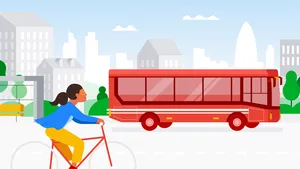How we’re helping everyone benefit from the transition to clean energy

Businesses and cities alike are making tremendous progress advancing 24/7 carbon-free energy (CFE). But access to the benefits of clean energy — like lower utility bills, cleaner air and job opportunities — remain out of reach for many households. That’s why, three years ago, we started a journey to better understand how we can help lower barriers to an equitable clean energy transition.
Today, we’re introducing two additions to our clean energy procurement strategy that respond to those challenges: one program extends clean energy's financial benefits to local communities and the other aims to spur long-term investments to improve housing infrastructure. Both of these programs are based on discussions with government officials, national non-governmental organizations (NGOs) and policy advocates about challenges to an equitable energy transition in their communities.
Expanding the financial benefits of clean energy
Over 30 million U.S. households face a high energy burden, spending a larger share of their income on energy bills compared to the average household. 1 Among this group, low-income Black, Hispanic and Native American households are disproportionately impacted. Additionally, these households often don't qualify for state and utility-led programs that would give them access to community or rooftop solar, and they often live in areas without access to clean energy.
Through a first-of-its-kind partnership with EDPR NA Distributed Generation, 2 we will create a 500-megawatt (MW) community-based solar portfolio, adding clean energy to the regional U.S. power grid PJM and providing Google with Renewable Energy Credits that contribute to our 24/7 CFE goal. What’s unique about this partnership is that at least 10% of the portfolio’s revenues will be redirected annually for up to 15 years as utility bill credits to more than 25,000 households facing a high energy burden.
As part of our commitment, Google will contribute Nest thermostats to select participating homes to further cut back on energy costs and encourage participation in demand response programs. Additionally, at least 35% of the projects will be built directly in low- and middle-income communities. This means, the portfolio will create local jobs, wages and tax revenues where it’s needed most, all while bringing additional clean energy to the local grid.
Closing the pre-weatherization gap for long-term energy efficiency
Direct utility bill credits can provide short-term relief. However, to lock in clean energy savings and reduce the energy burden long term, there needs to be meaningful investments in weatherization and housing infrastructure upgrades. Structural issues, poor insulation or inefficient appliances waste energy, resulting in high utility bills. Unfortunately, many homes in the U.S. — up to 15%, in fact — don’t qualify for government or utility efficiency upgrade programs because they haven’t completed costly “pre-weatherization” projects, like removing asbestos and repairing leaky roofs. As a result, utility bills stay high and energy (even if it’s clean energy) continues to go to waste.
To help narrow the pre-weatherization gap, we’re introducing Community Investment Funds in select geographies to pave the way for long-term energy efficiency — starting with a $12 million fund created through our EDP Renewables partnership. Local partner organizations will use the funds to help complete pre-weatherization projects for participating households and educate them on subsequent energy efficiency programs they’ll qualify for once the projects are done.
Similarly, we’ve partnered with Sol Systems 3 to provide funding to three rural electric cooperatives and one regional organization with deep roots in North Carolina and South Carolina to undertake critical home pre-weatherization and safety upgrades for low- and moderate-income (LMI) households. Alongside this investment, the partnership will deliver 225 MW of new solar energy and 18 MW of battery storage resources, moving us closer to 24/7 CFE and bringing clean energy to one of the most challenging grids to decarbonize.
Reducing the energy burden locally and globally
As we make progress against our 2030 goal to operate entirely on 24/7 CFE, we will continue to build upon these programs that extend the benefits of our investments to underserved communities. We’ll share our insights and lessons along the way and encourage others to join us so we can meaningfully reduce the energy burden in the communities we call home.







